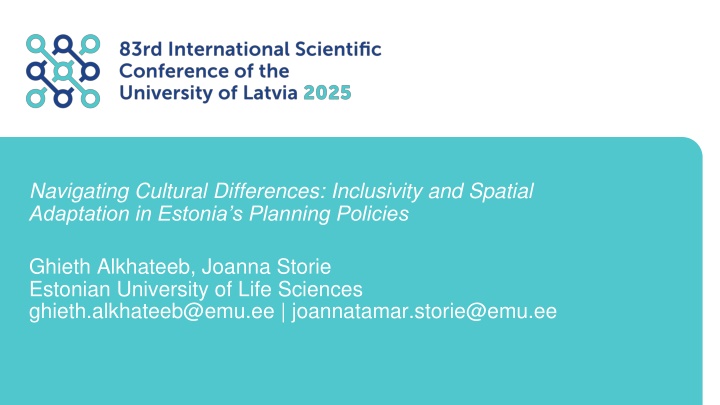
Spatial Adaptation in Estonian Planning Policies
Explore the nuances of spatial adaptation in Estonian planning policies, focusing on inclusivity and cultural differences. Discover how informal spatial practices influence the sense of belonging and the need for integration models that promote long-term social cohesion.
Download Presentation

Please find below an Image/Link to download the presentation.
The content on the website is provided AS IS for your information and personal use only. It may not be sold, licensed, or shared on other websites without obtaining consent from the author. If you encounter any issues during the download, it is possible that the publisher has removed the file from their server.
You are allowed to download the files provided on this website for personal or commercial use, subject to the condition that they are used lawfully. All files are the property of their respective owners.
The content on the website is provided AS IS for your information and personal use only. It may not be sold, licensed, or shared on other websites without obtaining consent from the author.
E N D
Presentation Transcript
Navigating Cultural Differences: Inclusivity and Spatial Adaptation in Estonia s Planning Policies Ghieth Alkhateeb, Joanna Storie Estonian University of Life Sciences ghieth.alkhateeb@emu.ee | joannatamar.storie@emu.ee
Introduction Democratic urban planning and marginalised spatial practices Informal spatial adaptations and the sense of belonging Spatial adaptation practices examples: repurposing urban spaces introducing cultural symbols Establishing communal gathering spaces 2
Reflections of Spatial Adaptation Practices Host communities experience a shift in their sense of place Planning frameworks do not address the co-existence of migrant and host spatial practices, leading to: potential tensions; or missed opportunities for an inclusive urban development The current focus of integration models misses how spatial adaptation could shape long-term social cohesion 3
Shift in Policy A policy that: recognises migrant-driven spatial adaptation as an essential component of integration; and enables host communities to adapt without threatening their own identity and sense of place 4
Narratives of Displacement Narratives of displacement and integration influence public perception and policy responses The "stranger" narrative, migrants are perceived as external agents introducing change to the host environment seen as disrupting local urban and cultural systems The host narrative: the focus is placed on how the established community experiences change in its surroundings 5
Narratives of Displacement Narratives influence how integration policies are framed Integration as obligation Policies that only focus on what migrants must "learn" to integrate risk overlooking the mutual adaptation process necessary for long-term 6
Connection to Public Spaces Public spaces are key arenas where integration plays out in everyday life. The way public spaces are designed, regulated, and used determines the engagement in shared experiences or remaining in separate social spheres. Negotiation over shared spaces: collaborations emerge; or conflicts arise 7

